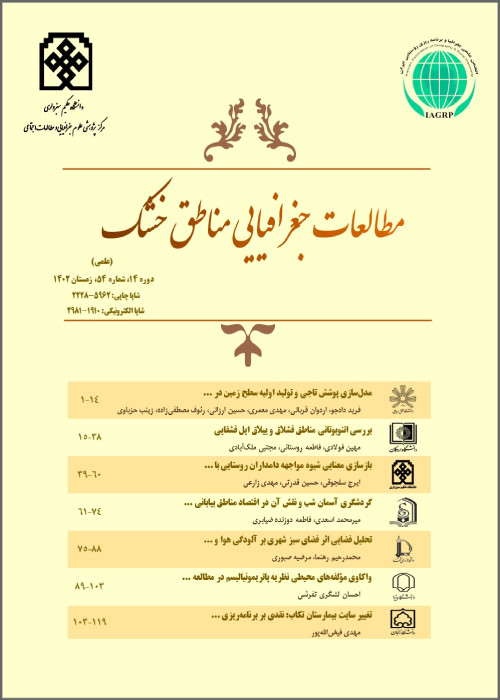Prioritization and Risk Management Model in Metropolitan Areas (Case Study of Mashhad Metropolis)
Today, risk management is an important part of the tasks of managers of organizations, institutions and geographical zones. This situation is more urgent in cities and for urban managers because cities are faced with different incidents due to concentration of resources and population, and urban managers seek to manage and control risk events in a way that minimizes damage and casualties. However, they usually do not achieve the desired results because of the numerous risks occurring in these zones, under the influence of different internal and external factors. However, most risk management research has been associated with the executive and economic projects, and its main purpose has been to prevent prolong processes, the increase of finished costs, waste of resources and position, and sometimes unfortunate events or loss of reputation. But with different events of recent years and the resulting financial damages and casualties, this has been on the agenda in cities. The sensitivity of these issues in urban areas is that any kind of risk that could lead to financial damages or casualties can lead to huge political as well as social crises that could cripple the sovereignty and political system. While this is considered quite common in the field of engineering and services, it has not yet been properly reflected in the urban and social contexts. Only experienced executives follow parts of the puzzle of systematic ways of identifying, analyzing, prioritizing and predicting urban risk mitigation measures relying on their own experiences. The process is intensified when there are major disasters and severe losses in which case little or no effect is observed despite high costs, because of hasty actions. This trend has also begun in Mashhad following the recent floods in Gonbad, Shiraz and Lorestan province. In fact, following these events, floods and rivers flooding that may not be of much importance in Mashhad have become the top priority for managers, with a great deal of costs spent in this regard. For this reason, the present study was conducted to systematically investigate the risk management conditions in this city and to determine the priorities while giving appropriate suggestions in this regard.
This applied study was carried out in a descriptive and analytical method. The required data were obtained through two researcher-made questionnaires. In the first stage, the main sample was asked to identify the main risk factors in urban areas, especially Mashhad. In the second stage, with 10% participation of the first sample, the factors collected in the first stage were prioritized and scored. The validity and reliability of the questionnaires used in this study were determined by experts in the field and was finally used in practice with the expertschr('39') approval and a score of 0.83 in the Cronbachchr('39')s alpha model. The population of the study consisted of all researchers and scholars working in the field of management, policy making and urban planning, of whom 200 individuals who were willing to participate in the study were selected and completed the questionnaires. Five-point Likert scale was also used to quantify responses. The collected data were evaluated through descriptive and inferential statistics using SPSS software, after which factors exacerbating and moderating urban risks were identified using risk prioritization technique and multi-criteria decision making method. Questionnaires were also administered along with face-to-face interviews.
The purpose of this study was to identify and prioritize some of the major risks of Mashhad metropolitan areas. To this end, a list of the risks of both human and natural groups was first prepared. Accordingly, a review of the related literature was carried out to complete and modify the list with the help of experts. After eliminating the unlikely risks or those with low effects, the priority number was calculated and identified for each risk area using expert opinions. The results showed 30 potential risks for Mashhad. After prioritizing human and natural risks, they were ranked by priority in a descending order through assigning a specific value to each in order to make policy making and planning of executive programs possible. Accordingly, risks which were given 20% of the highest scores were considered significant. In the meantime, risks with a probability rating of 8 and more were identified as critical hazards. According to these results, air pollution, rainfall and street runoff, as well as water pollution and shortage were ranked first to third with scores of 392, 192 and 180, respectively. Given that these events are quite different in terms of their occurrence and severity and fall into four categories of avoidance, transfer, control and acceptance in the urban risk management system, seven different strategies were proposed to prevent or reduce the damage caused by their occurrence. According to the financial and executive evaluations, empowerment of citizens and benefiting from the alternatives and options received the highest score among the suggested strategies. Accordingly, if the priorities identified in this study are taken into account and a systematic approach is followed, peoplechr('39')s trust and confidence in managers and administrators of urban affairs will be increased along with their participation in the process, while reducing damages of the potential risks. Overall, seven strategies were introduced in order of priority to deal with the prioritized risks in the present study the most prominent of which were empowerment of citizens and taking advantage of alternatives as well as options.
- حق عضویت دریافتی صرف حمایت از نشریات عضو و نگهداری، تکمیل و توسعه مگیران میشود.
- پرداخت حق اشتراک و دانلود مقالات اجازه بازنشر آن در سایر رسانههای چاپی و دیجیتال را به کاربر نمیدهد.



